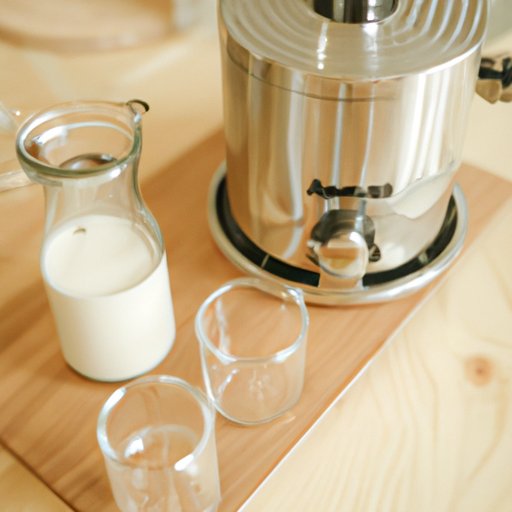
Introduction
If you’ve ever found a recipe that called for buttermilk, only to realize you didn’t have any, you’re not alone. Buttermilk is a common ingredient in many dishes, from pancakes and biscuits to fried chicken and baked goods.
But what is buttermilk, and why is it so important in cooking and baking? In this article, we’ll explore the different aspects of buttermilk, including how to make it at home, finding substitutes, the science behind it, and its nutritional value.
Homemade Buttermilk: Simple Steps to Upgrade Your Pancakes and Biscuits
Did you know that you can make buttermilk at home using just two ingredients? All you need is milk and either vinegar or lemon juice.
Here’s a simple recipe to follow:
- Measure out 1 cup of milk in a bowl.
- Add 1 tablespoon of vinegar or lemon juice to the milk.
- Stir the mixture together until well combined.
- Let the mixture sit for 5-10 minutes until it thickens and curdles.
- Use the buttermilk immediately, or cover and store it in the fridge for up to a week.
If you don’t have vinegar or lemon juice, you can also use cream of tartar or plain yogurt as a substitute.
For a helpful visual guide, check out this video tutorial on making homemade buttermilk:
Buttermilk Substitutes: Don’t Let a Missing Ingredient Ruin Your Dish
What can you do if you don’t have any vinegar, lemon juice, or other buttermilk-making ingredients on hand?
Fortunately, there are several alternatives you can use as a buttermilk substitute, such as:
- Plain yogurt
- Sour cream
- Milk and yogurt mixed together
- Milk and sour cream mixed together
- Milk and cream of tartar mixed together
When using a substitute, keep in mind that the flavor and texture of your dish may be slightly different. For example, using yogurt may lead to a tangier flavor, while using cream of tartar may lead to a less creamy texture.
Here are some recipe ideas where a buttermilk substitute could work well:
- Yogurt-marinated chicken
- Sour cream cornbread
- Cream of tartar pancakes
- Milk-sour cream biscuits
- Milk-yogurt smoothies
The Chemistry of Buttermilk: How Cultured Dairy Enhances Your Baking
Buttermilk isn’t just a flavorful ingredient; it also plays an important role in the science of baking.
Buttermilk is made through the process of fermentation, which occurs when bacteria are added to milk. This results in a tangy, slightly sour flavor and a thick, creamy texture.
When used in baking, buttermilk helps to activate the leavening agents (such as baking soda or baking powder) and create a fluffy texture. It also adds moisture and tenderness to your baked goods.
Here are some tips for using buttermilk in your baking:
- Replace regular milk or yogurt with buttermilk in recipes.
- Use buttermilk in place of sour cream or cream cheese for a tangy flavor.
- Combine buttermilk with baking soda to make your own baking powder.
The History of Buttermilk: From Waste Product to Culinary Staple
Believe it or not, buttermilk was originally considered a waste product in the butter-making process. When cream was churned into butter, a liquid byproduct was left over, which was often given to animals or thrown away.
Over time, people began to realize that buttermilk had a pleasant tangy flavor and was rich in nutrients. It became a common ingredient in many traditional dishes, such as Irish soda bread and Southern fried chicken.
Today, buttermilk is seen as a culinary staple and is used in recipes all over the world.
Health Benefits of Buttermilk: A Surprising Superfood for Digestion and More
While buttermilk may not be the first ingredient you think of when it comes to health foods, it does have several surprising benefits.
Buttermilk is low in fat and calories, making it a good option for those watching their weight. It’s also high in calcium, potassium, and other nutrients that can support overall health.
One of the most notable benefits of buttermilk is its ability to aid in digestion. The live cultures in buttermilk can help to balance the bacteria in your gut and promote healthy digestion.
Buttermilk also contains lactic acid, which can help to improve skin health and reduce inflammation. It may even help to boost your immune system and fight off infections.
To incorporate buttermilk into a healthy diet, try using it in smoothies, marinades, or dressings. You can also use it as a substitute for cream in soups and sauces.
Conclusion
There you have it – a complete guide to making buttermilk and finding substitutes, exploring the science and history behind this culinary staple, and highlighting its many health benefits.
Whether you’re making pancakes or fried chicken, don’t let a missing ingredient stop you from creating a delicious dish.




